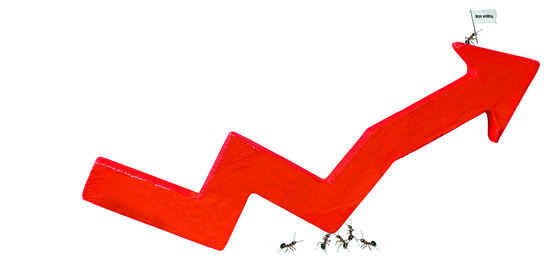
The Korean stock market opened its first 3,000 era thanks to the Donghak ant fever. Graphic = Choi Jong-yoon [email protected]
The stock market is like a miniature version of a national economy and industry. This is the reason why the perception of the Korean industry can be seen at a glance just by the aspect of the top companies with market capitalization, which are firmly guarding the stock market. On the 6th, when a new chapter in the Korean stock market was opened in the KOSPI 3000 era, we have followed the path that the Korean stock market has taken, centering on the top 10 companies in the KOSPI and KOSDAQ markets for the past 20 years.

Samsung Electronics’ market cap exceeds 500 trillion won. Graphic = Kim Eun-kyo [email protected]
Samsung Electronics ranks first in the total market cap of the KOSPI and KOSDAQ markets. After reaching No. 1 in the market cap at the end of 2000, it has maintained the unwavering first place as a listed company with the most expensive ransom (market cap) for 20 years.
[‘시가총액 톱10’ 20년 변천사 살펴보니]
Samsung Electronics is also the driving force behind the KOSPI rise, which has risen more than 30% since last November. In the love call of an individual investor, aka Donghak Ant, the share price of Samsung Electronics has soared 40% in the last two months. It was nicknamed ‘80,000 electrons’, and on the 5th, the market cap exceeded 500 trillion won based on the closing price. It has been 15 years since the market cap in January 2006 exceeded 100 trillion won.
Samsung Electronics’ position in the KOSPI is overwhelming. Only one share of Samsung Electronics in the total market capitalization accounts for 24%. Although it succeeded in touching the 3000 mark, it is interpreted that the KOSPI’s decline in 8 trading days may be influenced by Samsung Electronics, which was adjusted due to fatigue caused by the recent rapid rise. On this day, the stock price of Samsung Electronics closed at 82,200 won, down 2.03% from the previous day (83,900 won).
Breaking through the IT boom and entering the market cap of Samsung Electronics

Top stocks by historical market capitalization. Graphic = Kim Eun-kyo [email protected]
Unlike Samsung Electronics, which maintained a solid number one, competition for rankings below the second place in the market cap is fierce. According to Samsung Securities”Top 10 Changes in Market Cap’, in the early 2000s, when the information technology (IT) boom occurred, SK Telecom ranked second after Samsung Electronics. Until the late 1990s, KEPCO, which had been regarded as a “national democracy”, was pushed to fourth place.
Of the top 10 companies in the market cap in 2000, only Samsung Electronics has been named. Pohang Steel, Hantong Freetel, and Housing Bank disappeared as their current name changed or merged with other companies.
Baton Touch with cosmetics at Chahwajeong in 2015
In 2010, the heyday of’Chahwajeong (automobile, chemical, oil refinery)’ opened. Thanks to China’s rapid growth, the profits of exporting companies have increased significantly. The top 10 companies in the 2010 market cap included large exporters such as Hyundai Motor Company, Hyundai Mobis, LG Chem, and Kia Motors.
From 2015, investors’ interest in new growth stocks for cosmetics and biotechnology has grown. Amorepacific, which ranked fifth in the market cap in 2015, is representative. At the time, the company’s cushion products’sold one per second’ gained popularity as much as the word of mouth, and the stock price soared. AMOREPACIFIC’s market cap in 2015 was 24.23 trillion won, an increase of 10 trillion won in one year.
The’new edition’ that turns into the 4th industrial revolution and Corona 19
The industrial ecosystem is shaking again. Samsung Electronics, Hyundai Motors, Hyundai Mobis, SK Hynix, NAVER, and LG Chem have maintained the top 10 market cap over the past five years. Samsung C&T declined 8 stages from 4th to 12th. KEPCO, Amorepacific, and Samsung Life were all pushed out of the top 20. Instead, emerging runners from Samsung Biologics (4th), Celltrion (5th), Samsung SDI (7th), and Kakao (9th) filled the place where the old powerhouse left.
Kim Yong-gu, a research fellow at the Global Investment Strategy Team, Samsung Securities, said, “The fluctuations in the top-ranked stocks in the market cap reflect the expectations of investors for future business. Will be.” For example, the rise of electric vehicles as a new business in the world reflects this atmosphere by rising ransom prices (market caps) of Samsung SDI and LG Chem, which are domestic electric vehicle battery makers.
Celltrion is’outstanding’ in 5th place in market cap, beating Hyundai Motor Company
David’s odds against Goliath also came out. Celltrion, a pharmaceutical company with sales of about 1 trillion won, ranked 5th in the market cap, beating Hyundai Motor (8th), which makes 105 trillion won. This is because the stock price soared as investors flocked to the news of the development of an antibody treatment for a novel coronavirus infection (Corona 19). On the 6th, the share price of Celltrion was 353,500 won, which doubled from a year ago (173,000 won). Celltrion’s market cap (47,721.7 billion won) is more than 4 trillion won more than Hyundai Motor (43,374.6 billion won).
Kakao’s entry into the top 10 market cap also reflects the changes of the times. As the non-face-to-face (un-tact) service is gaining popularity due to the corona 19, the stock price is on the rise. Kakao’s stock price rose 156% in one year to 395,000 won, with a market cap of 34,976.7 billion won.
Lee Kyung-min, head of investment strategy team at Daishin Securities, said, “Unlike the past, individual investors are actively jumping into the new trend of industrial change.
Reporter Yeom Ji-hyun [email protected]
